A Paipo
Interview with Jerry Vasconcellos
July 18, 2012 - Honolulu, Hawaii
E-mail interview by Bob Green
Jerry has spent much of his life spreading the stoke
about paipo
boards. Besides organising contests he made paipo boards for kids
as part of his job with the Honolulu Parks Department. These boards
were made for free in local parks. Since 1970, Jerry has been making
sculptures from indigenous Hawiian materials.
|
1. When and
where did you
start riding a paipo? Who else was riding paipo boards at the time -
was it mainly kids your own age or were there older guys riding paipo boards?
I started riding paipos at The Wall in Waikiki.
Interesting place. Kind
of a wild frontier place. I would bus with my friends or brothers and
other kids would get dropped off by their parents or ride bike or bus.
It was all kinds of kids. The waves at the wall are perfect for
learning and yet complex enough to really train you. There are bowls
and double ups and second breaks and a whole lot to learn about so it
was a great training ground. It was mostly all kids but several what
seemed to be old men at the time and midrangers as well.
The boards
were all home made usually with straight sawed noses - that is two cuts
to draw the nose not to a point but to a nose - and when they had
skegs, they were usually attached with L brackets. Here and there was a
board that was rounded. These guys had access to a sabre saw or such.
Mostly plywood but 1x12s worked. It was cool because you didn't need
much. I got to ride a big, shaped-like-a-bullet board at Kawela Bay when
I was nine. Our house burned down and I ended up with the Dennis's in the
second to last house on the east road. We were actually in what they
call Turtle Bay, as in the Turtle Bay Resort - that was actually the
Kuilima. But anyway, that board was like a platform to me and it got me
thinking about what my next one would be like. |
|
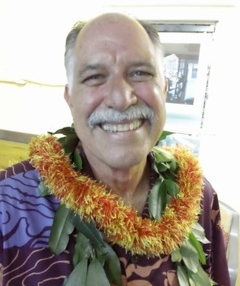
Jerry 2012.
Photo courtesy of Jerry Vasconcellos.
|
2. Who made your first board and what were the boards
like back then?
I don't recall my first board. I probably did
some sawing and painting
to make it. I do remember one with the nose maybe a foot wide straight
back to about 2 to 2-1/2 feet wide at the center for maybe a foot and
then in to a 1-1/2 foot tail. Painted green and I put resin on the
bottom. I wanted to do the top but it was my first time with resin and
I put all the catalyst into the quart can and shook it up and carefully
put the cap on nice and tight when I was pau covering the bottom. I was
stoked with the finish on the bottom but pissed because the can had
obviously harderned. I wasn't too interested in the boards as I had
mine and it was just too much fun surfing with it to worry about. Apart
from that board I rode out at Turtle Bay, I was having too much fun.
3. Do you know about the background to how the 1970
paipo and bodysurfing contest organised by Chuck Shipman came about?
What was the contest called?
The first contest at Makapu'u was called He'e
Nalu Makapuu. Chuck was
the original Ocean Recreation Specialist for the City and County of
Honolulu's Parks Department. He was tasked with the promotion and
education of the ocean as a recreational resource. He saw competition
as a means to honing one's skill and at the same time identifying the
guys that knew the sports. I ended up winning both the body surfing and
paipo boarding catagories and he offered me a job with the city teaching
and promoting them. I started at Kapiolani Park Bandstand across the
street from The Wall and we made boards and took kids to The Wall to
surf them.
Contest
t-shirt, 1974, designed by Stan Osserman; trophy awarded to Craig
Mattthew, 1981.
|
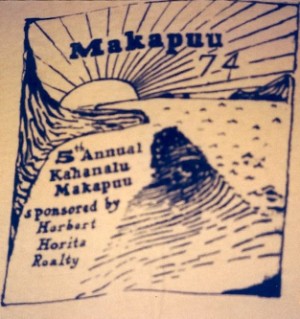
|
|
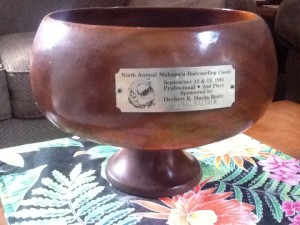
|
Photos courtesy of Craig Matthew.
4. I've read you won the contest that first year. What
did you have to do to get a high scoring ride? What else do you
remember about the contest?
That contest was fantastic! The waves were some
of the best Makapu'u
I've been in and I practically lived there for years. It was up to 8
feet and breaking cleanly out in the middle of the bay. The right was
all the way to the shorebreak while the left tended to peter out. The
size was intimidating but it was so clean and at that point I was
comfortable and I just surfed it for the enjoyment of it. We didn't
know competition at that point so it was just a matter of making the
best of the wave and with those waves there was a lot to have. The
standard we were told was the largest wave and the longest distance in the
most critical section. That was what we all were doing anyway so I
figured it to be just surf the hell out of it.
Contest t-shirt, 1971.
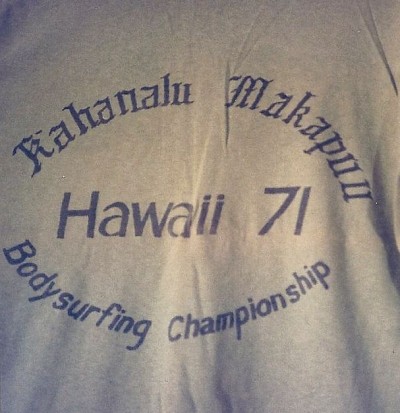
Photo by Craig Matthew.
Did the guys in the contests primarily ride on their
knees or prone? Was knee riding scored more highly?
During the early contests almost all the riders rode prone. As time
went on, however, more of us started exploring knee riding and the
numbers increased to maybe a third. Knee riding allows for a more
aggressive style with more radical cutbacks and maneuvering. It wasn't
scored higher unless the ride conformed more to the judging criteria. I
personally saw it as an exploration of the potential of the boards and
rider that I pursued for it's own sake.
Mercer Aikala at Point
Panic in a 1970s contest.
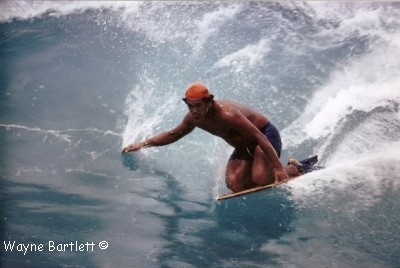
Photo and copyright to Wayne
Bartlett.
5. How did you come to direct the contest the following
year? How many years did you direct the contest?
After
the contest I was hired to be an Ocean
Recreation Specialist.
Body surfing and paipo boarding were my assigned specialties though we
did it all in those days. I started clinics and classes and also
established contests at Ehukai, (we weren't into Pipeline yet), Point
Panic and The Wall. The Wall was my favourite. The contest was called
the
"Waikiki Free Paipo" and it was a fun contest for all The Wall Rats.
The
kids themselves signed most of the waivers for that contest, as it was
too much trouble for them to take it home and have their parents sign
it. There were several future pro surfers that came through that
contest
and everyone had a good time. The Point Panic meet was dubbed the
"Honolulu Bodysurfing Championships" and paipo boarding was a category
along with handboard and surf mats. The Halona Point Bodysurfing
Association (or maybe club - I don't recall) put on a contest at Sandy
Beach that included paipo boarding. There were a handful of regulars
paipoing Sandy's. I surfed Makapu'u as in those days there was a big
social scene at Sandy's that I didn't feel a part of. Besides, I loved
Makapu'u as a gentler place on the whole. Sandy's with any sort of size
demands some serious respect. Most paipoing took place at half point
over the rocks and you didn't have that problem at Makapu'u. I believe
I ran the Makapu'u contest for 4 or 5 years. We wanted to pass them on
to the clubs as soon as they could do them and I believe there was some
sort of club that took it over. It's been a few years so there are a
lot of gaps.
Program of
the Third Annual Sandy Beach Bodysurfing Championships, 1974. The competition was started
in 1972, by the Halona Point Bodysurfing Association. Jerry won the 1972
competition and Mercer Akila won in 1973.
|
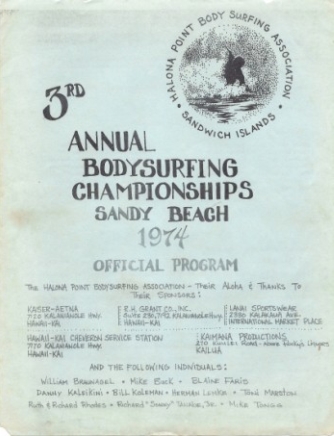
|
|
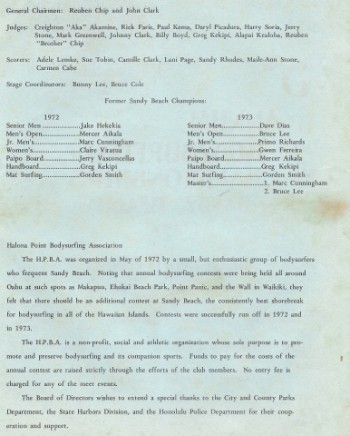
|
Photos courtesy of John Clark.
6. Did you generally get good waves for the contest? Was the contest always held at Makapu'u?
The Makapu'u Classic as it became known was
always run at Makapu'u. Ya
don't run the Kentucky Derby in New York. The surf generally was good.
We would have a holding period and hold out for better waves if it was
really junk. I think we may have not run it some years as we would
finally decide it wasn't gonna happen after a month of checking the
surf at the crack of dawn both Saturday and Sunday. We didn't have any
sort of indicators apart from wind in those days.
7. How many competitors would there be and where did
they come from? Did surfers from different areas have distinctive
styles?
There were maybe 60 to 70 competitors I'd say.
That would be for
different age groups , different catagories, and for men and women. I don't
recall any women paipo boarders. Makapu'u attracted folks from all
over. That was another thing I didn't really pay much attention to.
You'd see guys from Sandy's and Town and, of course, Waimanalo. I know
the Makapu'u style was the big drop and run style. It was really a
beautiful sight when the waves were big. The lines were drawn to take
you down the face and below the mush (the onshore lip) and it was all
about milking the incredible speed from the drop. Cutbacks were
wonderfully graceful as the boards by law could not have skegs.
8. Who are some of the paipo riders that stood out in
the contests?
Well, it's been a while. Some of the names I
remember, and not
necessarily in order of their abilities, but in my ability to remember
are George Paku, Mercer Aikala, Stan Osserman, Bud Scelsa, Sean Ross,
Craig Matthew, Harry Akisada, Tom Stone from The Wall, and of course Val
Ching.
Bud Scelsa riding
Pipeline during an early-1970s contest.
|
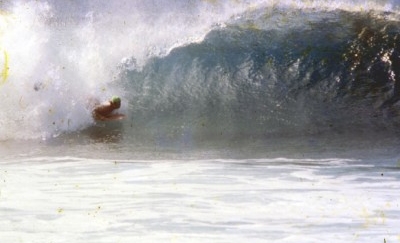
|
|
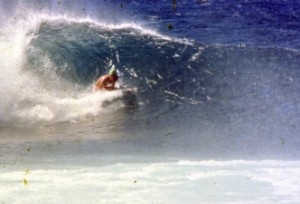
|
Photos courtesy of Bud Scelsa.
Bud Scelsa riding
Pipeline during an early-1970s contest.
|
|
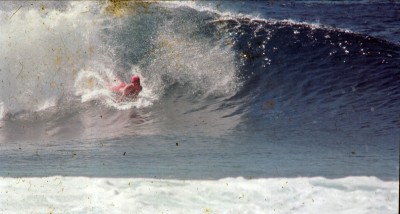
|
|

|
Photo courtesy of Bud Scelsa.
9. How did you get involved in building paipo boards for
kids and what was involved in this project? What material and tools did
you use?
When I worked for the Parks Department we had a
van that we took around
to the different playgrounds and we would make paipo boards. We used
3/8 marine plywood, a sabre saw, surform rasps and sandpaper. I made
three template boards, small, medium and large, and when arranged
properly we could get 6 boards per 4x8 sheet. The design was from the Paipo Nui but revised with straight rails and a slight curve on the
tail (mostly for comfort). They were good boards. I liked the medium
one and used it often for myself. We would cut the boards out and give
them to the kids to straighten the lines and bevel the edges and clean
it all up with the sandpaper. Those we let them decorate with poster
paint and spar varnish when pau. Generally not the best idea for
varnishing over the paint but it worked for the purpose and the kids
loved them. Later we'd arrange a beach day at The Wall, or "Sherwoods,"
in Waimanalo.
I worked for the parks department from 1971 through 1980, quit and
spent 15 years in the private sector before taking my old position
back. By the time I got back the focus was on Boogie boards,
bodysurfing, canoeing and canoe sailing so in many ways I left paipo
boarding back in the 1980s. When I left the city it was both times such
a relief to be out from under the absurd bureaucracy that I hit the
ground running away from all of it.
10. I've read that on one particular day you made 47 boards. What do you recall of this day?
Yeah, I remember that day. We were at the
Palama Settlement in Palama,
on Oahu. The kids were clamouring around like it was Christmas. More
and more came as word got out and we just kept laying up and cutting.
We reached a lot of kids that day.
11. What were the boards like that you made? Would you
later see any of these kids out in the surf?
Like I said, the design was from the Paipo Nui
but flat with straight
edges and a slight reverse curve at the tail. Most of them were ridden
at The Wall and they were around for quite a while. Many of the kids
"graduated" to stand-up surfboards as was the general perspective. I've
always despised that concept but the real glory was in "surfing" and
the paipo was viewed as a stepping stone to it. Paipo boards were
wonderful for
the financially challenged and there was always a lot of that, but to
their credit a lot of the kids really took paipo riding as far as they
could. There were a lot of really hot riders at The Wall. I loved
surfing The Wall on a good summer swell. Watching kids do their thing
with their boards and checking out the boards was so cool. Boogie
boards have taken the individual character out of it but remembering
the source as being the paipo board is always there.
Here are a couple shots of my last paipo. I just pulled it out from
under the house and noticed the tail section has been enjoyed by the
termites. Bummer! I used it for knee riding and was focused on more of
a kneeboard surfing style. George Greenough was always a hero of mine.
I worked with Ben Aipa on some surfboard building classes with the kids
and his "stingers" (like little rail skegs) are where the rails on this
board came from. It worked well for me.
Jerry's last
paipo
|
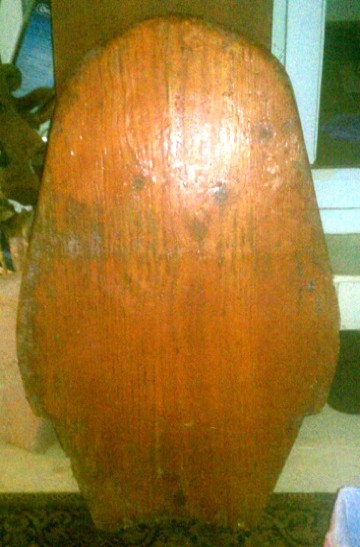
|
|
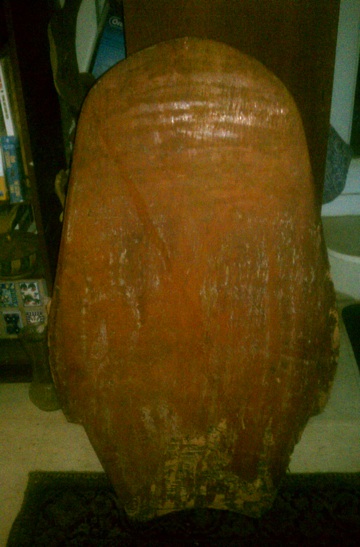
|
Photos by Jerry Vasconcellos.
12. How have your paipo boards changed from your first
board? How many years did you ride paipo boards?
I
started surfing in fifth or sixth grade,
going along with the
"graduating" concept, but gave it up after high school. No leashes in
those days and I spent a lot of time chasing my board and hated the
fact that you had to put yourself through some serious beatings to
protect your board. I got to be a pretty good bodysurfer chasing my
board all the time and I loved that both bodysurfing and paipo boarding
allowed you to dive under waves and not have to go through the
thrashing on the surface. I consciously decided I would be a bodysurfer
and paipo boarder at that point and haven't regretted it. I have a
10'0" longboard that sits at home and on the rare occasion I ride it
but it isn't the
same. I will admit to owning and using a boogie board these days as the
beating my elbows took on a hard paipo board is so not there on a
boogie. I suppose I could
pad the deck of my paipo and maybe I will. The only board I've got left
is the last one I used in competition and it's designed as a knee rider
and I don't do that anymore cuz of the banging my knees took. This
growing old stuff is for the birds. Oh well.
13. For you, is there any cross-over in the technique
between bodysurfing and riding a paipo?
I think there is. I am conscious of the
imperfections of the body as
far as board design is concerned and constantly try to flatten my
surfaces, at least mentally, when I ride. I was head judge of the
Pipeline Bodysurfing Classic for years and loved to watch Mike
Stewart bodysurf. He seems to forget he has no board. I never asked him
about paipo boards. He's probably ridden them but he grew up in the
boogie board era and more than likely only had boogies. I'll ask him
next time I see him.
14. Where did you mostly ride your paipo and is there any
particular surfs that stand out from over the years?
I
rode all over. For a long time it was Makapuu, The Wall, Publics,
Cliffs, Ala Moana (in the early days), and Magic Island when it was
built
(even Garbage hole before they buried it). Point Panic (in the early
days), Yokohama, Makaha, the entire stretch of the North Shore. Just
about
anywhere the wave needed the extra speed. I would body surf if it was
too radical like shorebreaks and such but basically wherever there was
a wave, I'd surf it. I even went to the U.S. Surfing championships one
year in Huntington Beach with my paipo in the kneeboard division.
Unfortunately the surf was a fridge, blown out foot high and it would
barely carry me on my knees. Reminded me of a terrible, blown out, way
too cold Kailua shorebreak.
15. What are your recollections of paipo surfing before
the boogie board? Where were the popular paipo surfing spots and who were some of the paipo surfers
that you remember?
I mentioned most of the names I recall in the
section about the
contests even though some of them didn't compete. My favorite watching
spot was Makapuu when it was going off. Harry, Stan, George Paku,
and Mercer just streaking across the water. Primo and Royal were hot Sandy
beach paipo boarders. I was always really impressed with what Sean Ross
did at Pipeline. He was the one that learned the line needed for a
skegless board there. I remember dropping in and going so fast that you
couldn't dig your rail and just shot straight into the flats in front
of the wave and losing speed and then just getting clobbered by the
lip. I usually bodysurfed instead.
Stan Osserman
and Frank Lee - contest surfing
|
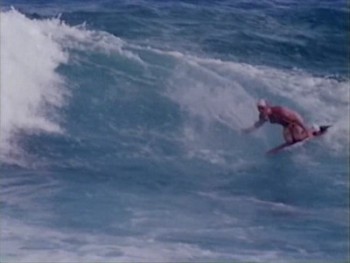
|
|
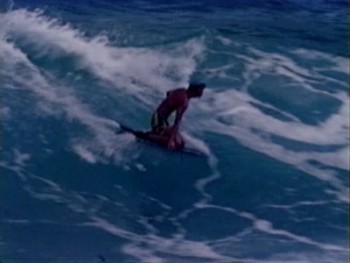
|
Photos by Wayne Bartlett,
courtesy of Stan Osserman.
I loved the speed and oft times out of control lines of China Walls at
Portlock and Publics on a big day. That is really one of paipo's real
standout features. Being able to draw a long speedy line and go.
Always wanted to paipo at Maalaea. Never got to.
16. Sandra Kimberley Hall, the biographer of Duke
Kahanamoku, advised me that your father dined with Duke the day he died
(January 22, 1968). Did you have much contact with Duke Kahanamoku?
I grew up at the Waikiki Yacht Cub in the Ala
Wai. Duke was this old
Hawaiian man who hung out there. The club was an all-white affair in
those days and as kids we were never given any reason to admire Duke.
We wondered what his deal was but were not encouraged to ask about that
sort of thing. Duke had a Manakai 20, a plywood catamaran designed by
Woody Brown. There were maybe 10 of them at the club and most of the
guys were not among the mainstream of the membership. These cats were
super fast and the yachties didn't know how to handle them so they were
an outside group. In a lot of ways they reminded me of skateboarders ,
totally into their thing and not really accepted by the mainstream. I
did sail with Duke (i was maybe 8 to 12 years old then) and always
loved the speed. It wasn't until much later that I came to know and
respect this man's achievements. I was close to Maroni Mederios who
worked at the Parks Department. He was the president of the Duke
Corporation. He was the one who took me to the U.S. surfing
championships. I worked on the Duke Kahanamoku Surfing Classic for many
years and even was awarded a "Duke" trophy for my bodysurfing and
paipo boarding. I regret not getting to know Duke better but enjoyed my
time with him as just another non-mainstream sailor. He got me going in
my sailing-for-speed quest. I love to just sail but I really love
sailing fast. Canoe sailing interisland for several seasons with the
Hawaiian Sailing Canoe Association were some great times.
17. When did your interest in art begin? What drew you
to sculpture and what for you is the continuing attraction?
I started as an artist in 1970, after I dropped
out of the University of Hawaii. Art 101 was
my main inspiration as my professor Duane Preble made it clear that if
you created it was your art. I live on a river and have worked with
stones pretty much all my life, making dams in the river mostly but
exploring carving them came naturally and from there to wood and
haven't looked back since. I actually started as a watercolorist and
acrylic painter but couldn't get past the need for "illusion."
Sculpture is real. I didn't have to deal with illusion and felt a lot
more comfortable as a sculptor. It's been a great time exploring the
possibilities of carving and managed to keep doing it through my career
with the city. I recently retired and was commissioned to do a large
piece for the new Cancer Research Center, in Kakaako, a stone's throw from
Point Panic. I'm arranging for a lot down in Kakaako to do the carving
and hope to hit Panic when there's waves.
Ocean Soul and
Dolphin form Koa on marble
|
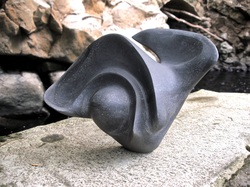
|
|
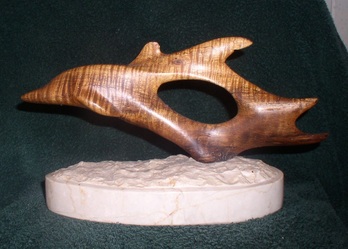
|
Photos by Jerry Vasconcellos.
18. Any other comments?
I've always maintained that surfing started
with man being pushed by
waves and then trying to go with them and soon they were bodysurfing.
Paipo surfing would follow as trying it with something to ride on and then
stand-up surfing has taking that to its next level. Paipo surfing has opened
the door to wave enjoyment for so many and it has since evolved into
boogie boarding and I love that there are those who appreciate it's
uniqueness and want to keep that going. Thank you, Bob, for your efforts
with this website and I appreciate what it means to the perpetuation of
this ancient sport.
|
Other
info: See Jerry Vasconcellos's
web-site for more of his sculptures. |
|